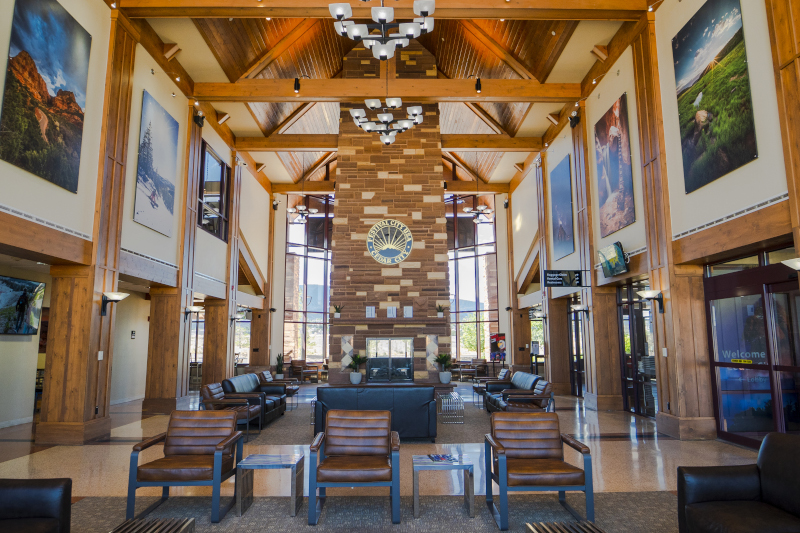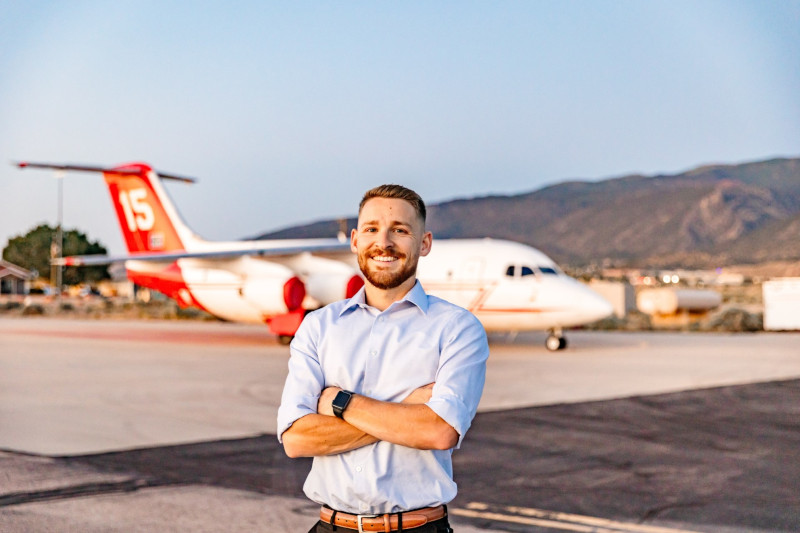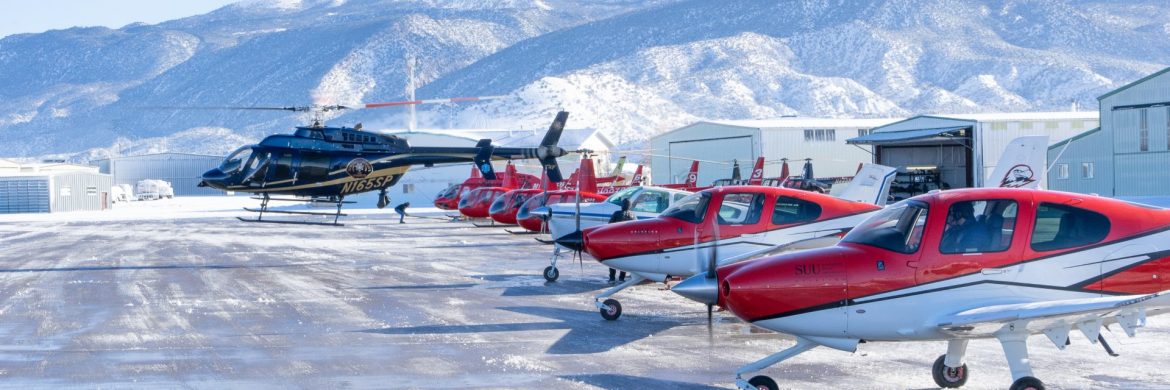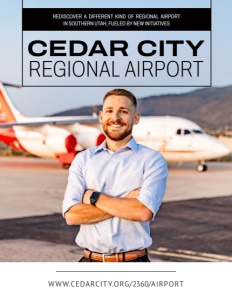Cedar City Regional Airport
Cedar City Regional Airport Takes Off into the New Year Ahead
Rediscover a different kind of regional airport in Southern Utah, fueled by new initiatives
Situated in historic Iron County, Utah, the Cedar City Regional Airport is well known for serving the southern section of a state renowned for its beauty. It’s a place of many popular tourist destinations, including picturesque mountain areas, rugged trails, National Parks and more. The airport can take you there and to many more charming locations in the great state of Utah.
We recently caught up with Cedar City Regional Airport Manager Tyler Galetka. He told us more about this facility of some 1040 acres, dating back about 100 years, and located two miles northwest of downtown Cedar City. It’s a place where smaller jets take off for Salt Lake City and beyond, Galetka informs.
“We are a commercial-service regional airport,” he reveals, “and we’re scheduled for service by a Delta connection flight operated by SkyWest Airlines, so we get about 12 flights a week right now. Essentially, right now the Cedar City Airport is pretty much like a general-aviation airport with some commercial service.”
The airport has a twofold nature, he adds, with aspects of both commercial service and general aviation.
The airline industry as a whole––always volatile, even in the best of times, Galetka notes––took a big punch from the recent COVID pandemic. Still, fortunately for Cedar City, even though it was not in the best market during the pandemic, as Galetka opines, it wasn’t among the airports with scaled-back operations. The usual 12 weekly flights remained in place.
In 2020, says Galetka, the airport’s runways were closed for reconstruction for about three months. That of course took a big toll on its commercial service. Yet now, a more business-as-usual feeling has returned. The airport is now on an upward trajectory, bouncing back to pre-COVID levels.
 “We’re always looking for progress and change,” says Galetka, who adds that, given fluid fuel costs and other such economic factors, he and his colleagues remain hopeful.
“We’re always looking for progress and change,” says Galetka, who adds that, given fluid fuel costs and other such economic factors, he and his colleagues remain hopeful.
Further, he continues, if ticket prices come down, demand shoots up, things will improve even more.
He says the airport benefits from the United States Department of Transportation federal subsidies.
This is the EAS or Essential Air Service program. It helps such smaller markets as Cedar City and other economically distressed areas, Galetka explains. It aims to maintain a minimal level of scheduled air service to communities that were served by air carriers before airline deregulation in 1978, according to the USDOT.
As the post-COVID economy improves, will Cedar City see growth? An optimist, Galetka admits even with challenges, the future is looking bright for us.
“We’re working heavily on airline development, but that’s not always certain,” he candidly allows, “so we always want to make sure we’re taking care of the airport as a general-aviation airport, as well as taking care of our tenants, who are very critical to our environment.”
Galetka shares that the airport’s main runway is 8,650 feet in length by 150 feet wide.
“We have a sizable runway,” he says, “not too large, but just enough for what we need. I don’t foresee any changes to our runway size in the next few years.”
He adds that Cedar City, beyond its runway upgrades, has benefitted from other infrastructural improvements. The terminal, distinctively designed to resemble a log cabin, had its apron rebuilt some six years ago along with some other aprons and taxiways since. In 2025, the entire parallel taxiway is slated to be rebuilt.
“Our whole airport is going to have almost brand-new asphalt within the next six years,” says Galetka, “so we’re very excited about that.”
Plus, he adds, a 4,000-square-foot expansion of the 17,000-square-foot terminal will mean enlarging its main holding room and baggage-claim areas. The latter will double in size, going from 500 to 1,000 square feet. Improved restrooms and vending areas are also planned. Further, the security checkpoint will feature more Transportation Security Administration equipment that, at present, cannot fit. Galetka adds “these areas have been overcrowded going on 11 years, when jet-service was first introduced in Cedar City.”
In all, says Galetka, it will amount to “really fantastic change,” continuing that, “We’ll go out to bid this winter and get our bids back probably by the first of the year, so we’re hopeful to break ground for the summer of 2024.”
He adds that timelines for these efforts’ fruition are subject to change, but right now, projections shoot for a 2025 completion.
A different kind of airport
Galetka observes that Cedar City Regional is a little different from its other counterparts.
“Infrastructure-wise, we haven’t had a whole lot of investment or opportunity to develop our hangars,” he notes. “Right now, the City only owns one row of T-hangars and then two executive hangars that are smaller in size. However, we do a lot of land leases here at Cedar City, where people can come out and invest money and build their infrastructure to rent out to sub-lease out or to occupy themselves.”
Keeping an eye on all of the pieces that form the bigger picture is Galetka’s goal: a good airfield for general aviation tenants, great runways, great taxiways, and very reliable service when it comes to the commercial side of things.
Among the important partners making things happen at the airport is Southern Utah University.
At more than a mile high in elevation, Cedar City Regional is among the highest airports in the country. Similarly, Southern Utah University’s flight-training school does indeed boast the highest altitude for such facilities in America. The university also offers training for prospective helicopter pilots.
“They also do fixed-wing training as well,” says Galetka, praising them as an invaluable asset to Cedar City, “and there are a lot of things going on with them, which is awesome. It’s changed the dynamic of Cedar City.”
He adds that yet more plans include looking to potentially invest some $2 million towards a taxi lane to reach an as-yet undeveloped part of the airport.
“I’d love to see some more development here at Cedar City, on the private side and the business side of the corporate,” he shares, “and that ties into the area that you have around the airport for leasing out to businesses.”
Returning to the topic of Southern Utah University’s flight school, he reveals that it was originally catered for helicopter pilots. However, since the school has expanded its efforts to include airplanes as well, things have grown at an exponential rate. Galetka says the school serves some 300 students in its flight training program.
This will, as he points out, have positive implications for America’s ongoing general dearth of pilots: a phenomenon unique to recent years, when, due to COVID and other such factors, many pilots have opted to take early retirements, thus creating a real void.
“I think they have 25 based helicopters here at Cedar City and about 17 fixed-wing airplanes,” he says, adding, “They’re cranking out students and pilots for this industry that we’re in, where we have a great pilot shortage. I know they have a partnership with SkyWest Airlines to get them pilots and in the right seat as soon as they’re out of school, which is fantastic. They’ve been producing a lot of pilots for the industry. We love that here in Cedar City.”
That high elevation helps give a real advantage to pilots training at Southern Utah University, as Galetka points out. Learning to fly over mountains is crucial to any pilot’s training.
 More about Galetka
More about Galetka
A Cedar City native, born and raised, Galetka admits to being something of a paradox. Whilst he has no flying background, he nonetheless has a great interest in aviation and its history, especially during World War II. Cedar City Regional was then involved in training pilots to fight the Germans and Japanese. Galetka shares that he finds it fascinating how much things have changed in aviation in the past 80 years. Plus, as a kid, he also enjoyed watching P-3 Orion and P-2 Neptune firefighter airplanes take off from Cedar City.
“I’d have my mom take me to the fence, and I’d watch them take off and land all day long, fighting a wildfire,” he recalls, “and that’s kind of where my passion for aviation sprouted.
Growing up, I didn’t honestly expect this to be the line of work that I’d be in. I did join the military, serving in the National Guard for eight years. I wanted to go into aviation, but there were no local units for the Army air side of things with helicopters in my area. I chose to do a different job in the military.”
Then about eight years ago, he started working at Cedar City Regional, fueling aircraft, before attending college. This caused him to fall in love with aviation more deeply. After putting in his dues and learning the trade, Galetka has moved seamlessly through the ranks of the exciting aviation management side of the airline industry.
Fast-forward a few years, and now Galetka is heading up a dynamic gem of an airport as it flies into a brighter future fueled by first-tier initiatives.
AT A GLANCE
Cedar City Regional Airport
What: a regional airport owned by the Cedar City Corporation
Where: two miles northwest of Cedar City
Website: www.cedarcity.org/2360/airport




